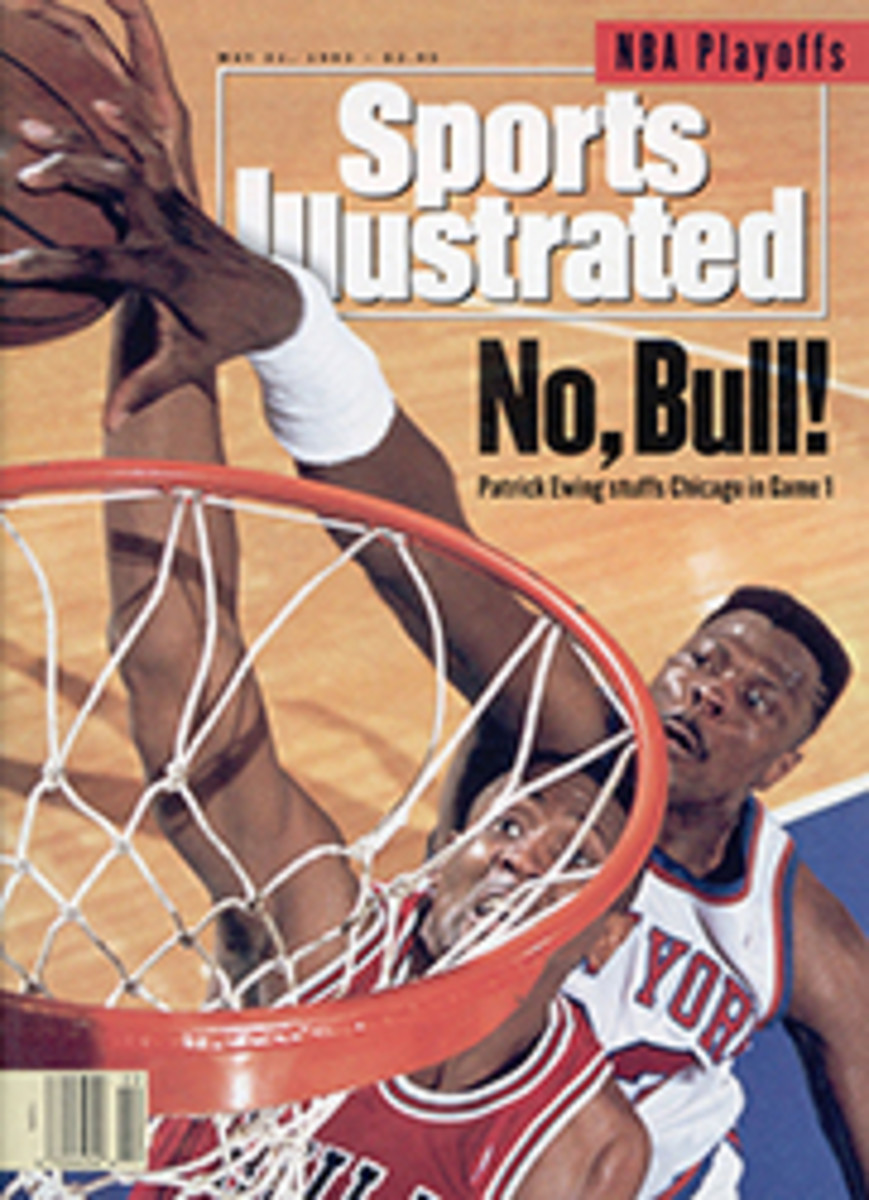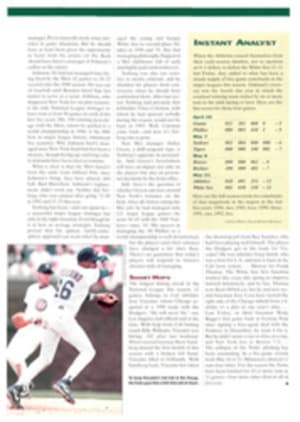
Cooperstown East
A Tourist Attending a baseball game in Japan at, say, the Tokyo Dome or Nagoya Stadium could be excused, after taking in a couple of banner-waving, card-flashing, team-anthem-chanting innings, for assuming that people who are this fanatic about baseball must have invented the sport. Baseball was brought to Japan in 1873 by an American teacher named Horace Wilson. But it is fair to say that the singular affection the Japanese have for baseball has led them to lend their own sensibility to the game. An entertaining introduction to baseball Japanese-style is provided by that country's version of Cooperstown, The Baseball Hall of Fame and Museum of Japan, which has existed for five years underneath the Tokyo Dome in the heart of the city.
A tour of the museum begins, sensibly enough, in The Clubhouse. Contemporary Japanese baseball is the theme of this room, which features two large glass cases, one for each of Japan's two major leagues in the Japan League. The cases are divided into six compartments—or lockers—each containing a full uniform for one of the league's six teams.
In one of the 12 compartments there is a jersey worn during the 1980s by the Yomiuri Giants' cleanup hitter, Tatsunori Hara. In another is a bat that was hefted by Ralph Bryant, a former Los Angeles Dodger who is a gaijin (foreigner) on the Kintetsu Buffaloes and has played with the team since 1988.
Baseball fans everywhere have heard of Japan's most famous player, Giant slugger Sadaharu Oh. In his 22 years with the team, Oh-San hit 868 home runs. Before each game he would stand in front of a large mirror in the clubhouse in Korakuen Stadium and scrutinize his swing. Between the clubhouse and the museum's second large room is a short hallway where the mirror now hangs opposite a silhouette of Oh. Visitors are encouraged to step up to the mirror and "practice hitting with Mr. Oh."
Beyond Oh's looking glass is a room called The Field, which honors record-setting careers on the diamond. Visitors are invited to settle upon a dugout bench once used by the Giants; "Mr. Oh sat here," a museum guide informed me. Behind the bench is a montage of photographs, including a large picture of Eiji Sawamura, who, as a 19-year-old fire-baller for a team of amateur Japanese stars, pitched against a team of touring American professionals in 1934. He struck out Babe Ruth, Jimmie Foxx and Lou Gehrig, but his team lost 1-0. Sawamura's lifetime ERA was 1.74. After he was killed at sea near Taiwan during World War II, Japan's equivalent of the Cy Young Award for pitching excellence was named after him.
Across the room is a projection screen on which visitors can watch a 10-minute movie about baseball in Japan during the past 60 years. And how's this for Japanese technology? A visitor simply waves a hand in front of the screen to watch clips of Babe Ruth unfurling his swing during the 1934 tour (Ruth remains nearly as popular in Japan today as Oh); Hiroshi Oshita, who played for the Toei Flyers from 1946 to '59, using his famed green bat; and Emperor Hirohito attending his first and only professional game, in 1959. That historic contest was won by the Giants on a home run by Shigeo Nagashima, the second member—with Oh—of the team's devastating cleanup duo that led the team to nine consecutive Japan League titles. The clip covering Nagashima's retirement in 1974 still reduces many Japanese fans to tears.
Elsewhere in The Field are displays honoring Japanese versions of celebrated American players: Yutaka Fukumoto, "the Japanese Lou Brock," who stole 1,065 bases for the Hankyu Braves during the 1970s and '80s; Sachio Kinugasa, "the Lou Gehrig of Japan," who played in 2,215 consecutive games as a Hiroshima Carp outfielder in the 1970s and '80s; Masaichi Kaneda of the Yakult Swallows, "Japan's Nolan Ryan," who shares the American pitcher's uniform number, 34, and who, from 1950 to '69, had 4,490 strikeouts.
Next comes the History of Baseball room. Visitors from the U.S. will be interested in an exhibit that prominently features American ballplayers in Japan. There is a photograph of Horace Wilson, looking very much like a schoolteacher; bats owned by Ty Cobb, Willie Keeler and Cap Anson; and the warmup jacket Ruth wore during the 1934 tour, when he led the U.S. players to a 17-0 record against Japan's amateurs.
A professional league began in Japan in 1936, but the country's high school tournament goes back to 1915, and there is a display honoring that annual event. Other exhibitions pay homage to Japan's long tradition of college baseball, club baseball and rubber-ball leagues. On a wall around the corner is some soft padding identical to that which covers the outfield walls in the Tokyo Dome; visitors are invited to crash into it a couple of times to test its effectiveness. There is also a small theater that offers short three-dimensional movies. Three-D glasses are given to visitors when they enter, and one quickly realizes that this film is not for the faint of heart or belly, since most of the show consists of fastballs and line drives zooming toward the audience.
Suitably weak-kneed, the visitor walks past plaques honoring the 110 men who have been elected to the Hall of Fame since its establishment in 1959. The white-and-bronze room looks like a Zen version of Cooperstown, but there is a significant difference between U.S. and Japanese standards for induction. To be eligible in Japan a player must have been retired from all aspects of the professional game for five years. Thus Oh, who stopped playing more than a decade ago, is not yet a Hall of Famer because he managed the Giants until 1989.
Despite the many American players who have gone to Japan and done exceedingly well—such as 1985 triple crown winner Randy Bass—there are no gaijin in this Hall. There is, though, a plaque for Victor Starfin, a Russian pitcher for the Giants who came to Japan as a child just after World War I, after fleeing the Bolsheviks, and one for Tadashi Wakabayashi, a Hawaii-born pitcher who played for a number of Japanese teams and was known as Mr. Seven Colored Breaking Balls for his vast repertoire of curves.
One of the nicest features of the Hall is its 29,000-volume library. A considerable number of the books and periodicals are in English, making the facility a trove for Western travelers. Included are such treats as first editions of Albert G. Spalding's Baseball 1911, Henry Chadwick's The Sports and Pastimes of American Boys, published in 1884, and Charles Peverelly's Book Of American Pastimes, dated 1868. Those who can't read Japanese are encouraged to thumb through the collection of old Japanese newspapers; the photographs are often magnificent.
The Tokyo Dome, a ringer for the Minneapolis Metrodome and locally known as the Big Egg, is home to both the Nippon Ham Fighters and the Giants. If tickets are available, a ball game makes a terrific finale to a museum expedition. If the day's game is a sellout, there are myriad other diversions within a few hundred yards' walk, including a large amusement park, a movie theater, Humpty's Garden, which offers hot dogs and hamburgers to those who spurn sashimi, and the Tokyo Dome Baseball Cafe, where patrons can dine on American ballpark food—at Japanese prices—while taking in the game on television.
For those who come to the Far East looking for more than baseball, try the Edo Koishikawa garden, a few blocks west. It's pretty and there's no ballplaying allowed.
TWO PHOTOS
TAKEO TANUMA
Left, the uniforms of the 12 Japan League teams. Above, a rarity from the sizable library.
PHOTO
TAKEO TANUMA
Ruth toured Japan in 1934 with a team of U.S. players.
PHOTO
TAKEO TANUMA
Pro baseball began in Japan in 1936; shown are buttons from early uniforms.
PHOTO
TAKEO TANUMA
The museum is nestled in the basement of the Big Egg.
The Baseball Hall of Fame and Museum is at 1-3-61 Koraku, Bunkyo-ku in Tokyo. It is open Tuesday through Sunday, year-round. Admission is 350 yen ($3.25) for adults and 150 yen for children. The telephone number is 03-811-3600.

